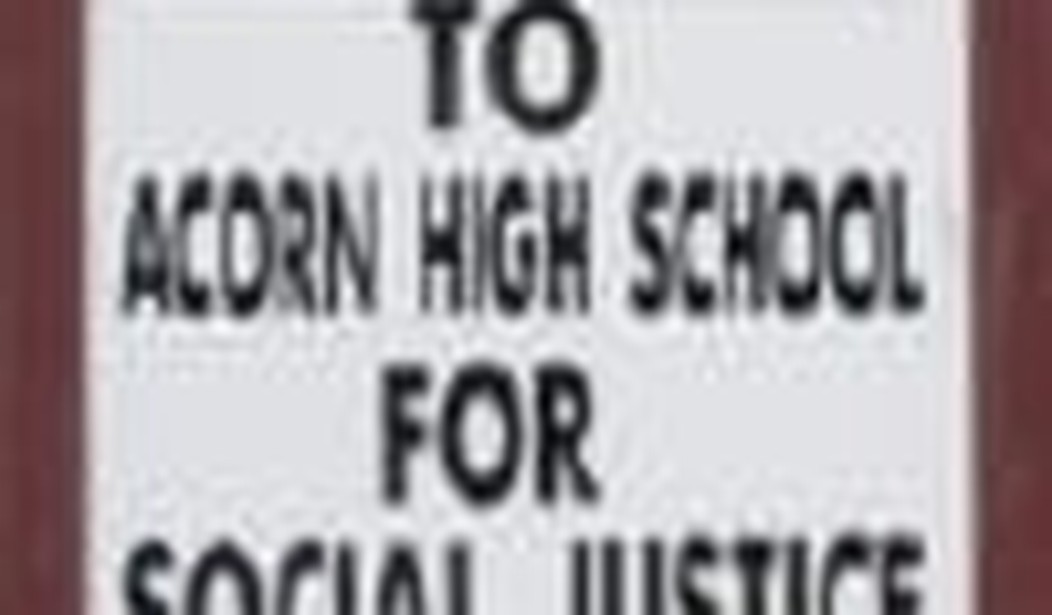Vouchers could end up funding a “school of the jihad,” Hillary Clinton told the Milwaukee Journal-Sentinel recently. Other choice critics warn of the School of Satan or Klan Kollege Prep.
But eccentric public schools don’t require vouchers. As districts start small schools and innovators create charters, tax funds already are going to create public schools organized around a left-wing political vision. “The movement to link education, social justice and activism is appealing to a growing number of educators and community organizations around the country,” writes Adam Doster in The Nation. Social justice charters and district-run programs have opened in New York City, Chicago, Los Angeles and Oakland in recent years.
Social Justice High at Chicago’s Little Village Lawndale High School campus tries to teach “critical inquiry through projects and problems centered on race, gender and economic equity,” as well as skills that will prepare students to excel on tests and go on to college.
One day a week is set aside for discussion groups. As Doster describes it, students in one class discuss the meaning of “community,” looking for a local issue they can work on, while another group down the hall talks about “racial stereotypes in the media as an entree into the idea of hegemony. Hands pop up across the packed classroom as students argue about how advertisements influence the way society views larger populations.”
In theory, students become engaged in learning when they see the connection between the classroom and the world in which they live. They can build on what they know, rather than being frustrated by what they don’t know.
The Nation provides examples:
A science teacher can plant an urban garden, allowing students to learn about plant biology, the imbalance in how fresh produce is distributed and how that affects the health of community residents. An English teacher can explore misogyny, or materialism in American culture through the lens of hip-hop lyrics. Or as Rico Gutstein, a professor of mathematics education at the University of Illinois, Chicago, suggests, a math teacher can run probability simulations using real data to understand the dynamics behind income inequality or racial profiling.
Does it work? So far, there’s little evidence that “social justice” motivates, engages, or educates students. Themed schools of all types tend to succeed when led by a strong principal who hires competent teachers.
ACORN High School for Social Justice in Brooklyn, founded by a grassroots group, fell into chaos. “Parents today are releasing a report describing a school where gang recruiting is ongoing; where just a quarter of teachers stay more than two years, and where even a low graduation rate, 37%, is propped up by many students who pass merely by showing up to class,” reported the New York Sun on Dec. 6. The principal was forced out a few weeks later.
By contrast, the Community School for Social Justice in the Bronx is showing progress. Students work as interns at the nonprofit Citizen’s Advice Bureau, health centers, schools, parks, and a public legal defense organization. An Inside Schools report described students doing academic projects that might be tackled at any creative school:
For example, 11th graders grow plants and experiment with turning waste into resources in the science class. A natural water filter is set up in the room; dark, dirty water in a large tank passes through a series of smaller tanks with stones and plants until it comes out clear at the end. Tenth graders wrote original plays in English class, some of which were chosen to be performed by professional actors at the Manhattan Theatre Club, another of the school’s affiliates.
In the search for engagement, students may spend too much time talking about what they already know and not enough learning new things. If students start their discussion of Macbeth by talking about power struggles in neighborhood gangs, that’s fine. If they write a rap and then write a performable play, OK. But it’s easy to write the rap and call it a day. (Most raps have the literary and intellectual value of greeting-card verse.)
Some fear “social justice” students will be encouraged to think of themselves as past, present and future Victims of the System. Maybe so. But “hope” sells a lot better than self-pity. Most young people won’t choose a school that teaches hopelessness. For one thing, it’s boring.
I have no problem with “social justice” schools as long as parents and students choose that approach, the kids end up with at least a basic education, and the schools that fail are allowed to go under. Competition and choice . . . It’s the American way.
Joanne Jacobs, who blogs on education at joannejacobs.com, is the author of Our School, the story of a charter school that prepares Mexican-American students for four-year colleges.









Join the conversation as a VIP Member